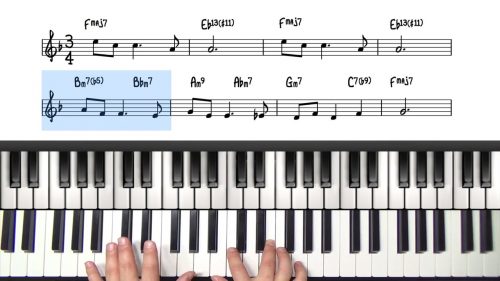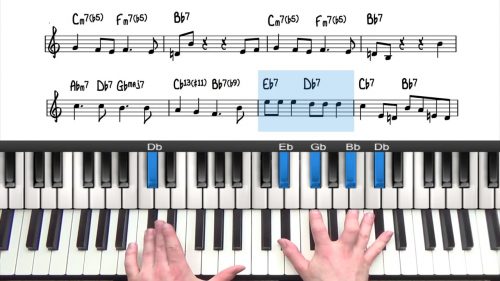Embraceable You Stride Style
In part 1 of this tutorial, we created an introduction and then worked through the A1 and B sections of the tune. We kept the voicings relatively simple and added some reharmonisations and passing chords in places.
In part 2 of this tutorial, we will increase the complexity of the chords to create a climax in the second half of the tune. To achieve this we will increase the spread of the voicings over the keyboard to add more impact to the melody.
In our left hand we will introduce a stride style in places. This will help establish the pulse and keep a sense of forward motion throughout the changes.
Practice Tips
-
This lesson illustrates how you can repurpose the melodic motifs as an improvised ending.
-
To do this, simply choose a memorable motif from the melody and then superimpose it over a I-VI-II-V progression in the key of the tune.
-
Embraceable You is written in the key of G Major and so we use the chords G6 (Imaj6), E7alt (VI7alt), A-7 (II-7) and D7b6 (V7b9).
-
Try superimposing different parts of the melody over this 1625 progression. Some parts will work better than others. Experiment.
-
You can rephrase the melody to suit the underlying harmony. Don't be afraid to add or remove tones if they clash.
-
Remember that a big part of the motif is the rhythmic element. You can often play completely different notes, but ensure the rhythm is coherent and consistent with a memorable phrase from the tune's melody.







I find diminished chords harder than any other chord structure. When I play a piece I can “hear” a diminished chord coming, but have trouble deciding which one. For example, in bar 13 of “embraceable you” the two melody notes in the second half of the bar are G and F#. If I’m playing by ear the G would suggest an E diminished when in fact the correct chord is a D# dim to go with the F#. It makes tunes like “slow boat to China”, which uses all three,, and “wish upon a star”, a nightmare. Maybe I should think of them as flat 9ths instead. Any suggestions?
Love the site. Thanks.
Hi George, thank you for writing!
To answer your question about the diminished, first I want to mention that there is a typo in the lead sheet in the tutorial; In the bar 13 should have B7b9 (not Bb7b9) as the alternative chord for D#dim, as the B7 is moving to the next chord E-7.
Now to the diminished chords. You have to think of diminished chords as dominant chords, always resolving to the next chord in one way or another. In this case in the bar 13 the D#diminished chord functions as a B7 -> E-7 (check the attachment).
Now, if you think of the dim chord as B7, the melody fits fine, as it is part of B7 – E-7 harmony (attachment).
This is also the case with the songs you mentioned, the melody doesn’t necessarily have to fit the dim chord, as the dim chord is just a variation of the actual harmony, which is V-I.
This is why even when improvising, you can play F#m7b5 – B7 (II V) material over the D# diminished chord and it fits totally fine (example in attachment).
To get more insight of the diminished chords and their functionality, go check out 5-minute masterclass:
pianogroove.com/jazz-piano-lessons/diminished-patterns-licks-improvisation/
Also, check out Jazz Theory Discussion thread on the subject, and feel free to add questions/ideas there!
pianogroove.com/community/t/all-about-diminished/3179
Thanks, let me know if you have any further questions,
-Tuomo
Thanks for the heads up with the typo Tuomo… it has been corrected.
For some reason your image upload has not displayed, it might be a problem with the website.
Can you try and upload it again and see if it works?
Thanks!
Hayden
Trying to send the picture again, this is the attachment to my previous comment
Thanks Tuomo, I can see the image now but it’s very small. I think there may be a problem with uploading images in comments.
I will forward to the tech guys to take a look.
Cheers and enjoy Easter Monday! :-)
Hayden
I was able to work out the file attachment and watched the master class. I had never thought of diminished chords as a V before but it makes a great deal of sense and simplifies the approach immensely.
Thanks.
I’m happy to hear George, keep up the good work!
-Tuomo